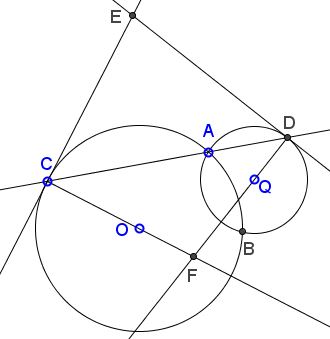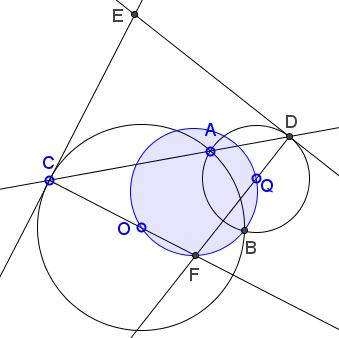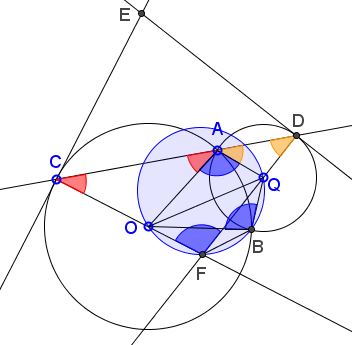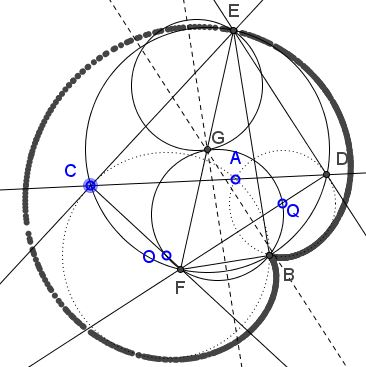Pure Angle Chasing II
What Might This Be About?
Problem
Circles $(O)$ and $(Q)$ intersect in $A$ and $B;$ $C$ on $(O);$ $AC$ meets $(Q)$ second time in $D.$ $F$ - the intersection of $CO$ and $DQ;$ $E$ the intersection of the tangents to $(O)$ and $(Q)$ at $C$ and $D,$ respectively.

1) Prove that $EB\perp BF.$

2) Prove that points $O, F, B, Q$ are concyclic.

Solution to Part 2
This is a quintessential "angle chasing".
Triangles $ACO$ and $DAQ$ are isosceles: $\angle OCA=\angle OAC$ and $\angle QAD=\angle QDA.$

In $\Delta CDF,$
$\begin{align}\angle OFQ &= \angle CFD\\ &=180^{\circ}-\angle FCD-\angle FDC\\ &=180^{\circ}-\angle OCA-\angle QDA, \end{align}$
$\begin{align}\angle OAQ&=180^{\circ}-\angle OAC-\angle QAD\\ &=180^{\circ}-\angle OCA-\angle QDA\\ &=\angle CFD, \end{align}$
- $\angle OAQ = \angle OBQ,$ because of the symmetry in $OQ.$
It follows that $\angle OFQ = \angle OBQ,$ implying that the four points $O,F,B,Q$ are concyclic.
Solution to Part 1
Observe that $\angle CBD$ does not depend on a specific position of $C.$

Further,
$\begin{align}\angle CBD &= \angle CBA + \angle ABD\\ &=\angle ACE+\angle ADE\\ &=180^{\circ}-\angle CED. \end{align}$
So that $B$ lies on circle $CDE.$ But, since $\angle ECF=\angle EDF=90^{\circ},$ this is exactly the circle with diameter $EF.$
Angle $EBF$ being subtended by a diameter of $(CFBDE)$ is, therefore, right.
Looking back
With the dynamic diagram it is hardly possible to miss the fact that the center of $(CED)$ lies on $(OFBQ).$
First of all, observe that circle $(OFBQ)=(OBQ)$ is stationary - it does not depend on the position of $C.$

As point $F$ traces the $(OBQ)$ circle, the perpendicular bisector of $BF$ meets the circle at $G,$ and the reflection $E$ of $F$ in $G$ traces a cardioid with the cusp at $B.$ This is quite suggestive and looks good, but does not answer the question: the fact is that the center of $(CED)$ lies on $(OBQ)$.
One possibility to prove that is to show that the perpendicular bisectors of $BF$ and $BD$ meet on $(OBQ).$ As Murray Klamkin once wrote "small solved and unsolved problems lead to larger solved and unsolved problems..." I'll treat that problem separately.
Let there be two circles $(P)$ and $(Q),$ with $Q$ on $(P);$ $F$ a point on $(P);$ $D$ an intersection of $FQ$ with $(Q).$

Prove that the intersection $E$ of the the perpendicular bisectors of $BF$ and $BD$ lies on $(P).$
Acknowledgment
I borrowed the basic problem from Antonio Gutierrez after he broadcasted it at tweeter.com.
Chasing Inscribed Angles
- Munching on Inscribed Angles
- More On Inscribed Angles
- Inscribed Angles
- Tangent and Secant
- Angles Inscribed in an Absent Circle
- A Line in Triangle Through the Circumcenter
- Angle Bisector in Parallelogram
- Phantom Circle and Recaptured Symmetry
- Cherchez le quadrilatere cyclique
- Cyclic Quadrilateral, Concurrent Circles and Collinear Points
- Parallel Lines in a Cyclic Quadrilateral
- Reim's Similar Coins I
- Reim's Similar Coins II
- Reim's Similar Coins III
- Reim's Similar Coins IV
- Pure Angle Chasing
- Pure Angle Chasing II
- Pure Angle Chasing III
|Contact| |Front page| |Contents| |Geometry|
Copyright © 1996-2018 Alexander Bogomolny71536666
